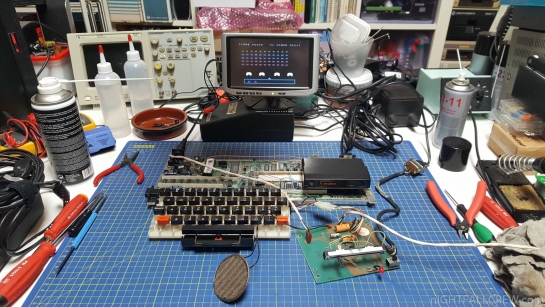
Texas Instruments TI-99/4 Fixed
Defect:
- Garbage screen on startup immediatly or after a couple of minutes.
Fix:
- This defect is very similar to the one of the Coleco Vision console.
The problem are the pins oxidized of the power switch, i have sprayed R-11 and the problem it’s disappeared completely.
I left turned on the computer for more than 2 hours and i have made a 50 x power cycle (ON/OFF) and the problem is no longer appeared.
Note:
I thought there had to be a VDP RAM problem with a diagnosis made remotely without having the TI-99/4 in the laboratory.
To avoid using the lame RF modulator i have used a standard Commodore 64 composite cable that works very well with a NTSC composite video output.
Gallery:
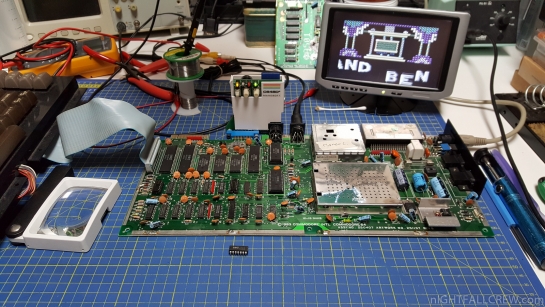
Commodore 64G repaired (1 of 2)
Defect:
Repair:
- Replaced 1 x MOS 7707 (7406) U8
Note:
- The motherboard has been repaired several times, the technician probably in a previous life was a butcher.
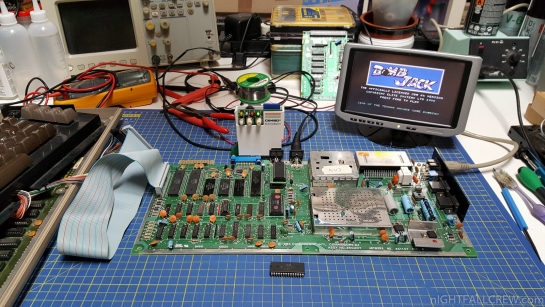
Commodore 64 repaired (2 of 2)
Defect:
- Garbage screen but runs programs perfectly.
Repair:
- Replaced 1 x MOS 906114 (PLA) U17

Ikari has released a new firmware for the SD2Snes Flash Cartridge (Super Nintendo/Famicom). The upgrade instructions can be found here.
Changelog:
- major overhaul of the in-game hook code, with more help from the FPGA, to significantly reduce CPU footprint. This improves hook compatibility with a variety of games.
- in-game hook: avoid disruption of manual controller reads (fixes controls in Super Star Wars games)
- new option: “Hide file extensions” (effective after next directory change)
- do not silently fail to load saved games when the sd2snes/saves folder does not exist (create the folder instead)
- do not silently fail to load/save cheat files when the sd2snes/cheats folder does not exist (create the folder instead)
- Cx4 core now runs at exactly 20Mhz
- fixes:
- MSU1: avoid missed control register status changes on rapid rewrites (fixes FF3 Dancing Mad, Zelda FMV missing audio)
- fix auto region patch timing (hopefully)
- fix DSP1 header detection (fixes Ballz 3D JPN)
- add reset hook to boot games on start of frame only (fixes Boogerman PAL)
- clear entire SPC700 RAM (do not spare IPL area) – fixes echo artifacts in many games
- minor cosmetic changes:
- resize SPC player loading window
- prevent flickering letters on System Information screen
Download:
source: sd2snes.de

SNDH archive v4.6 released - 345 new/updated SNDH files (437 subtunes) – (total 9893 tunes)
Ever since the birth of the Atari ST, different chip music formats have had different ways to use them. If you are coding a chip music player for the Atari ST you would have to use dozens and dozens of special ways to replay music.
But in the mid 90′s, BDC of Aura crew became tired of this inelegant system and decided to fix the issue once and for all. He then created the ‘SNDH’ file format. SNDH is actually the original songfile and replaycode with a header bolted on top of the music and replayer. The header has a unified calling interface no matter what type of chip music is hidden beneath it, and it has extended datas about the music.
Download: SNDH Atari ST YM2149 Archive v4.6 (1269)
source: sndh.atari.org

The MixSID is a stereo SID board for the C64 that can be used with any combination of SID models on a wide range of C64 mainboards.
Features include an integrated stereo channel mixer, pragmatic stereo addressing scheme, flexible handling of io areas, onboard audio input, output and digiboost circuits, dedicated stereo output, full paddle compatibility and versatile digital control.
source: henning-bekel.de

The 13th X party will be held from October 28th until October 30rd 2016. The party will be at the location: De Hoof 18, Someren – the Netherlands. Competitions: C64 Demo, C64 Music and C64 Graphics.
source: x-2016 homepage

Some new games or tools (Cracked / Trained or Unrealeased) for Commodore 64 have been released from your favorites groups.
Titles:
- Kill the Alien
- Super Breakout Preview +
- Breakaway V1.1
- Hover Raider RX +2H [seuck]
- Paintress +2
- Yatzy
- Planet Golf Preview +1D
- Space Invadaz Extra Preview
- C64ColQuiz +1H
- F-Clash 64 [seuck]
- C64ColQuiz
- Blaster Twins Preview
- Die! Alien Slime +8D
- Kill the Alien +2
- Uni Games Preview V0.24
- Zetio +1DT
- Fort Django +
- Fort Django
- Iron Lord [1581,FD,HD]
- Spaceman Splorf: Planet of Doom V1.1 +2MD
- Retro Bombers Preview 1
- Color Overload
- Super JumpKick Turbo 64 (Beta)
- The Uni Games V0.3
- The Uni Games Preview V3 (CommVEx release)
- Agent-Test +2T
- Gradius +2DMFGH
- Nemesis – The Final Challenge +2DMFGH
- Croll Ship +4D
- Ghost Chaser +5D
- World Conquest
Download: All Games in One Archive (3593)
source: csdb.dk

Apple Computer 1, also known later as the Apple I, or Apple-1, was released by the Apple Computer Company (now Apple Inc.) in 1976. It was designed and hand-built by Steve Wozniak. Wozniak’s friend Steve Jobs had the idea of selling the computer.
The Apple I was Apple’s first product, and to finance its creation, Jobs sold his only means of transportation, a VW Microbus, and Wozniak sold his HP-65 calculator for $500. It was demonstrated in July 1976 at the Homebrew Computer Club in Palo Alto, California.
—————————————————————————————————————————————————
Apple 1 (Mimeo / Mike Willegal Clone) Assembled for a friend of mine; Paolo Cognetti.
Many thanks for the Technical & Moral support to: Piero Todorovich and Alessandro Polito.
I also thank for some electronic components: Gabriele Molesto Zaverio of Museo Dell’informatica Funzionante, Piero Todorovich.
I had several problems with this Apple 1 clone, i very briefly describe the problems below and i attach some photos of the assembling stages.
- 1 – No video image, all voltages are ok.
- 1 + MPS3704 Transistor failure replaced with a 2N3704 pinout not compatible.
- 2 – Garbage screen during boot.
- 2 + Replaced 2 of 7 Shift Register 2504V
- 3 – Keyboard inputs not working, the WOZ monitor is freezed and shows an “@ \” but the “\” does not wrap.
- 3 + Replaced a 27k resistor half broken, probably during transport the capacitor has crushed the resistor.
- 4 – The keyboard does not respond correctly, typing A they print @, typing 1 they print 0 … and so on …
- 4 + Keyboard adapter from Apple II/+ to Apple 1 in short circuit. A wire is skewered in a pin of a Socket.
- 5 – The computer does not respond correctly, but it seems to work. The WOZ monitor responds to commands but does not write to memory and print random locations.
- 5 + Replaced a 7410 which had a pin always at high level.
- 6 – The keyboard has several problems, some switches are completly dead.
- 6 + Replaced switches.
Photos of the assembling stages:
Video:
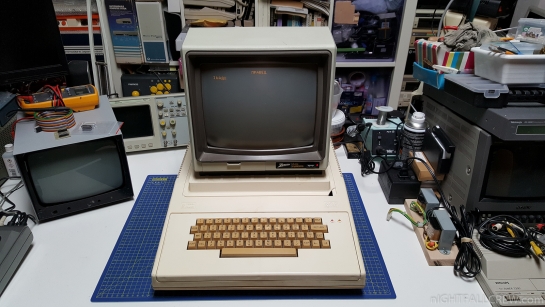
Defect:
- Dead and then Garbage screen.
Components replaced/fixes:
- 1 x CPU 6502 (DH8)
- 1 x RAM MN4164P (DC3)
- One switch of the DIP Switch was in a wrong posistion.
- Fixed the connection of the original lamp (power on led) with the pins cutted.
- Inserted the missing Z80 CPU (DF8)
The keyboard is not working correctly, some keyboard keys are totally dead.
Gallery of the repair:
Pravetz computers
Pravetz (Правец in the original Cyrillic, series 8 and series 16) were Bulgarian computers, manufactured mainly in the town of Pravetz. Some components and software were produced in Stara Zagora, Plovdiv, and other Bulgarian cities.
The first Bulgarian-made personal computer, IMKO-1, was a prototype of the Pravetz computers that were developed by Ivan Vassilev Marangozov, who was often accused of cloning the Apple II. A few early models were produced at the ITKR (pronounced ee-teh-kah-reh, Institute of Technical Cybernetics and Robotics), a section of the Bulgarian Academy of Sciences. Industrial production in Pravetz started shortly after.
Pravetz computers were of major importance in the economy of the Comecon.
In October 2013, a privately held Bulgarian company claimed in their website to have the rights on the trademark and misleadingly announced that “Pravetz Computers are returning to market”. In fact, the company has no link to the original “Pravetz” computers known during the Soviet Era.
Advertisement:
source: wikipedia
 SpartaDOS X (or SpartaDOS 4.0) is a disk operating system for the Atari 8-bit family of computers, that closely resembles MS-DOS. It was developed and sold by ICD, Inc. in 1987-93.
SpartaDOS X (or SpartaDOS 4.0) is a disk operating system for the Atari 8-bit family of computers, that closely resembles MS-DOS. It was developed and sold by ICD, Inc. in 1987-93.
Ten years later SpartaDOS X considered abandonware has been picked up by its enthusiasts, and developed further. These unofficial revisions, incorporating many of the utilities written since 1992, cleaning many identified problems and including numerous improvements.
Highlights:
- Improved compatibility of 1 MB RAMBO and 576k Compy Shop RAM extensions with the internal BASIC on XL/XE.
- CAR.COM: added support for the Weronika cartridge: to run the dedicated programs, use CAR /F filename.ext;
- INIDOS.SYS should now work for SIDE2.
- Fixed a major bug in the S_VBXE driver, which caused occasional hang ups after the Reset key was pressed.
- CON.SYS: 80-column mode can now survive a warm reset.
- CHKFAT.COM: new command line tool to verify FAT file systems compatibility with our FATFS driver
- New program: MD5 hash tool
- SC now version 1.0.0
Please read the release notes (the whatsnew.txt file) for full information.
The new SpartaDOS X 4.48 runs on the following hardware platforms:
- intSDX128 and intSDX128 “flash”
- IDE Plus 2.0 interface (*)
- Maxflash 1Mb
- Maxflash 8Mb (*)
- Maxflash MyIDE+Flash
- MyIDE II RAM
- MyIDE II ROM
- SIC! Cartridge 256k (*)
- SIC! Cartridge 128k
- SIDE HDD cartridge (*)
- SIDE2 HDD cartridge (*)
- SuperCart cartridge (*)
- Ultimate1MB (*) (**)
- Turbo Freezer 2005 (*) (***)
- Altirra and Atari800 emulators
(*) – includes MAN on-line help
(**) – also use with Incognito board and Turbo Freezer 2011
(***) – use with Freezer ROM only
Dowload: SpartaDOS X 4.48 with Toolkit (1373)
source: sdx.atari8.info wikipedia
Sorry, this entry is only available in Italian.

Below the post of the author on Atariage Forum.
A new firmware and flashtool is availible for Sys-Check V2 series.
The new flashtool now supports both Sys-Check PCBs equipped with a SST39SF010A flash chip (V2.1 and V2.2). When you start the flashtool, it will ask you which version you have. To be absolutely sure, the flashtool shows a simplified graphic view of both versions. I think, everybody can handle it :)
Of course the flashtool (and all other documents) are written in german and english.
Also there´s a new firmware V1.4 out. This firmware can be used with ALL Sys-Check versions – also with the old V2.0 (without flash). Owners of the V2.0 must burn the 16 KB firmware image into a 27128 EPROM. All other please use the flashtool to update their Sys-Check.
V1.4 has this minor changes:
- Sys-Check can be used with the U1MB expansion.
- The new version first checks the whole memory (to be more exact… the first 48 KByte) and then displays the defective bits (if there are any…)
- When bad memory within the first 48 KB is found, the upper 16 KB will not be tested.
- If memory is fine, OS-ROM will be tested as before.
- If both tests are fine, then pressing START after this will set Sys-Check into endless loop test mode. Memory and OS-ROM are tested infinite – until any error occurs.
- During memory tests the background will be coloured red if defective bits were detected.
Download: Sys-Check Firmware & Tools v2.2 (1086)
source: atariage.com
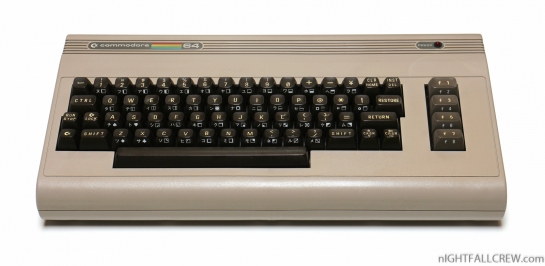
The Japanese Commodore 64 was introduced in the 1983.
The Hardware somewhat different (and incompatible) Kernal and BASIC to accomodate Japanese katakana characters, 46 total (plus punctuation, diacritics, etc.); many graphic characters replaced in the Char ROM with the new Japanese characters.
Breadbox case and original brown keycaps; SHIFT-LOCK replaced with C= LOCK for the purpose of getting at the katakana; modified keycaps to show the new characters with the colour keys no longer present and the remaining graphic characters significantly rearranged.
Machine started up in English but different colour scheme and only 36863 bytes free; see screenshot. Both Markus and On the Edge remember the original screen as black on pink, but the screenshot and corresponding ROM definitely aren’t.
Graphics and Sound Identical to the breadbox 64.
Gallery:
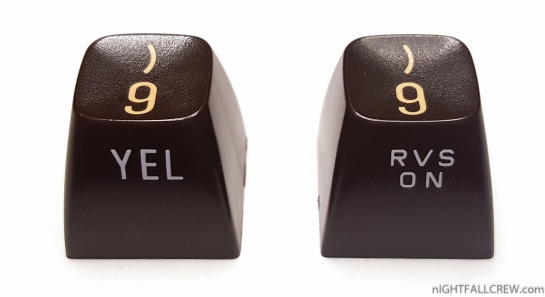
Directly from the collection of a dear friend “Andrea Pierdomenico” the Commodore 64 with the wrong key.
The factory was wrong to print the “8″ key but only the upper label and not the front label. I did not find any articles on the net that talks about this keyboard, the only one in the world?
Gallery:

The High Voltage SID Collection (HVSC) is a freeware hobby project which organises Commodore 64 music (also known as SID music) into an archive for both musicians and fans alike.
The work on the collection is done completely in the Team and contributors’ spare time and is proudly one of the largest and most accurate computer music collections known.
This update features (all approximates):
- 1022 new SIDs
- 811 fixed/better rips
- 24 repeats/bad rips eliminated
- 791 SID credit fixes
- 143 SID model/clock infos
- 59 tunes from /DEMOS/UNKNOWN/ identified
- 1 tunes from /GAMES/ identified
- 70 tunes moved out of /DEMOS/ to their composers’ directories
- 4 tunes moved out of /GAMES/ to their composers’ directories
Download:
source: www.hvsc.c64.org















 SpartaDOS X (or SpartaDOS 4.0) is a disk operating system for the Atari 8-bit family of computers, that closely resembles MS-DOS. It was developed and sold by ICD, Inc. in 1987-93.
SpartaDOS X (or SpartaDOS 4.0) is a disk operating system for the Atari 8-bit family of computers, that closely resembles MS-DOS. It was developed and sold by ICD, Inc. in 1987-93.




Recent Comments